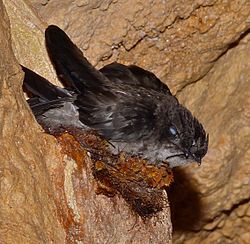| Mossy-nest swiftlet | |
|---|---|
 | |
 | |
| Scientific classification | |
| Kingdom: | Animalia |
| Phylum: | Chordata |
| Class: | Aves |
| Clade: | Strisores |
| Order: | Apodiformes |
| Family: | Apodidae |
| Genus: | Aerodramus |
| Species: | A. salangana |
| Binomial name | |
| Aerodramus salangana (Streubel, 1848) | |
| Synonyms | |
Collocalia salangana | |
The mossy-nest swiftlet (Aerodramus salangana) is a species of swift in the family Apodidae. Some taxonomists consider it to be a subspecies of the uniform swiftlet. It is found in northern Borneo, the Natuna and the Derawan Islands and Nias island off western Sumatra. Its natural habitat is subtropical or tropical moist lowland forests.
